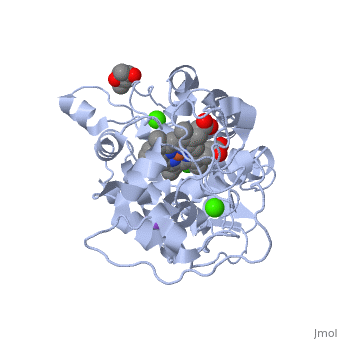|
|
| (3 intermediate revisions not shown.) |
| Line 1: |
Line 1: |
| | + | |
| | ==Trametes cervina lignin peroxidase== | | ==Trametes cervina lignin peroxidase== |
| - | <StructureSection load='3q3u' size='340' side='right' caption='[[3q3u]], [[Resolution|resolution]] 1.85Å' scene=''> | + | <StructureSection load='3q3u' size='340' side='right'caption='[[3q3u]], [[Resolution|resolution]] 1.85Å' scene=''> |
| | == Structural highlights == | | == Structural highlights == |
| - | <table><tr><td colspan='2'>[[3q3u]] is a 1 chain structure with sequence from [http://en.wikipedia.org/wiki/Trametopsis_cervina Trametopsis cervina]. Full crystallographic information is available from [http://oca.weizmann.ac.il/oca-bin/ocashort?id=3Q3U OCA]. For a <b>guided tour on the structure components</b> use [http://oca.weizmann.ac.il/oca-docs/fgij/fg.htm?mol=3Q3U FirstGlance]. <br> | + | <table><tr><td colspan='2'>[[3q3u]] is a 1 chain structure with sequence from [https://en.wikipedia.org/wiki/Trametopsis_cervina Trametopsis cervina]. Full crystallographic information is available from [http://oca.weizmann.ac.il/oca-bin/ocashort?id=3Q3U OCA]. For a <b>guided tour on the structure components</b> use [https://proteopedia.org/fgij/fg.htm?mol=3Q3U FirstGlance]. <br> |
| - | </td></tr><tr id='ligand'><td class="sblockLbl"><b>[[Ligand|Ligands:]]</b></td><td class="sblockDat"><scene name='pdbligand=CA:CALCIUM+ION'>CA</scene>, <scene name='pdbligand=CL:CHLORIDE+ION'>CL</scene>, <scene name='pdbligand=HEM:PROTOPORPHYRIN+IX+CONTAINING+FE'>HEM</scene>, <scene name='pdbligand=MPD:(4S)-2-METHYL-2,4-PENTANEDIOL'>MPD</scene>, <scene name='pdbligand=NA:SODIUM+ION'>NA</scene></td></tr> | + | </td></tr><tr id='method'><td class="sblockLbl"><b>[[Empirical_models|Method:]]</b></td><td class="sblockDat" id="methodDat">X-ray diffraction, [[Resolution|Resolution]] 1.85Å</td></tr> |
| - | <tr id='gene'><td class="sblockLbl"><b>[[Gene|Gene:]]</b></td><td class="sblockDat">tclip ([http://www.ncbi.nlm.nih.gov/Taxonomy/Browser/wwwtax.cgi?mode=Info&srchmode=5&id=1111950 Trametopsis cervina])</td></tr>
| + | <tr id='ligand'><td class="sblockLbl"><b>[[Ligand|Ligands:]]</b></td><td class="sblockDat" id="ligandDat"><scene name='pdbligand=CA:CALCIUM+ION'>CA</scene>, <scene name='pdbligand=CL:CHLORIDE+ION'>CL</scene>, <scene name='pdbligand=HEM:PROTOPORPHYRIN+IX+CONTAINING+FE'>HEM</scene>, <scene name='pdbligand=MPD:(4S)-2-METHYL-2,4-PENTANEDIOL'>MPD</scene>, <scene name='pdbligand=NA:SODIUM+ION'>NA</scene></td></tr> |
| - | <tr id='resources'><td class="sblockLbl"><b>Resources:</b></td><td class="sblockDat"><span class='plainlinks'>[http://oca.weizmann.ac.il/oca-docs/fgij/fg.htm?mol=3q3u FirstGlance], [http://oca.weizmann.ac.il/oca-bin/ocaids?id=3q3u OCA], [http://www.rcsb.org/pdb/explore.do?structureId=3q3u RCSB], [http://www.ebi.ac.uk/pdbsum/3q3u PDBsum]</span></td></tr> | + | <tr id='resources'><td class="sblockLbl"><b>Resources:</b></td><td class="sblockDat"><span class='plainlinks'>[https://proteopedia.org/fgij/fg.htm?mol=3q3u FirstGlance], [http://oca.weizmann.ac.il/oca-bin/ocaids?id=3q3u OCA], [https://pdbe.org/3q3u PDBe], [https://www.rcsb.org/pdb/explore.do?structureId=3q3u RCSB], [https://www.ebi.ac.uk/pdbsum/3q3u PDBsum], [https://prosat.h-its.org/prosat/prosatexe?pdbcode=3q3u ProSAT]</span></td></tr> |
| | </table> | | </table> |
| | + | == Function == |
| | + | [https://www.uniprot.org/uniprot/Q60FD2_9APHY Q60FD2_9APHY] |
| | <div style="background-color:#fffaf0;"> | | <div style="background-color:#fffaf0;"> |
| | == Publication Abstract from PubMed == | | == Publication Abstract from PubMed == |
| Line 15: |
Line 18: |
| | From MEDLINE®/PubMed®, a database of the U.S. National Library of Medicine.<br> | | From MEDLINE®/PubMed®, a database of the U.S. National Library of Medicine.<br> |
| | </div> | | </div> |
| | + | <div class="pdbe-citations 3q3u" style="background-color:#fffaf0;"></div> |
| | | | |
| | ==See Also== | | ==See Also== |
| Line 22: |
Line 26: |
| | __TOC__ | | __TOC__ |
| | </StructureSection> | | </StructureSection> |
| | + | [[Category: Large Structures]] |
| | [[Category: Trametopsis cervina]] | | [[Category: Trametopsis cervina]] |
| - | [[Category: Calvino, F R]] | + | [[Category: Calvino FR]] |
| - | [[Category: Martinez, A T]] | + | [[Category: Martinez AT]] |
| - | [[Category: Miki, Y]] | + | [[Category: Miki Y]] |
| - | [[Category: Romero, A]] | + | [[Category: Romero A]] |
| - | [[Category: Lignin peroxidase]]
| + | |
| - | [[Category: Oxidoreductase]]
| + | |
| - | [[Category: Trametes cervina]]
| + | |
| Structural highlights
3q3u is a 1 chain structure with sequence from Trametopsis cervina. Full crystallographic information is available from OCA. For a guided tour on the structure components use FirstGlance.
| | Method: | X-ray diffraction, Resolution 1.85Å |
| Ligands: | , , , , |
| Resources: | FirstGlance, OCA, PDBe, RCSB, PDBsum, ProSAT |
Function
Q60FD2_9APHY
Publication Abstract from PubMed
Trametes cervina lignin peroxidase (LiP) is a unique enzyme lacking the catalytic tryptophan strictly conserved in all other LiPs and versatile peroxidases (more than 30 sequences available). Recombinant T. cervina LiP and site-directed variants were investigated by crystallographic, kinetic, and spectroscopic techniques. The crystal structure shows three substrate oxidation site candidates involving His-170, Asp-146, and Tyr-181. Steady-state kinetics for oxidation of veratryl alcohol (the typical LiP substrate) by variants at the above three residues reveals a crucial role of Tyr-181 in LiP activity. Moreover, assays with ferrocytochrome c show that its ability to oxidize large molecules (a requisite property for oxidation of the lignin polymer) originates in Tyr-181. This residue is also involved in the oxidation of 1,4-dimethoxybenzene, a reaction initiated by the one-electron abstraction with formation of substrate cation radical, as described for the well known Phanerochaete chrysosporium LiP. Detailed spectroscopic and kinetic investigations, including low temperature EPR, show that the porphyrin radical in the two-electron activated T. cervina LiP is unstable and rapidly receives one electron from Tyr-181, forming a catalytic protein radical, which is identified as an H-bonded neutral tyrosyl radical. The crystal structure reveals a partially exposed location of Tyr-181, compatible with its catalytic role, and several neighbor residues probably contributing to catalysis: (i) by enabling substrate recognition by aromatic interactions; (ii) by acting as proton acceptor/donor from Tyr-181 or H-bonding the radical form; and (iii) by providing the acidic environment that would facilitate oxidation. This is the first structure-function study of the only ligninolytic peroxidase described to date that has a catalytic tyrosine.
Crystallographic, kinetic, and spectroscopic study of the first ligninolytic peroxidase presenting a catalytic tyrosine.,Miki Y, Calvino FR, Pogni R, Giansanti S, Ruiz-Duenas FJ, Martinez MJ, Basosi R, Romero A, Martinez AT J Biol Chem. 2011 Apr 29;286(17):15525-34. Epub 2011 Mar 2. PMID:21367853[1]
From MEDLINE®/PubMed®, a database of the U.S. National Library of Medicine.
See Also
References
- ↑ Miki Y, Calvino FR, Pogni R, Giansanti S, Ruiz-Duenas FJ, Martinez MJ, Basosi R, Romero A, Martinez AT. Crystallographic, kinetic, and spectroscopic study of the first ligninolytic peroxidase presenting a catalytic tyrosine. J Biol Chem. 2011 Apr 29;286(17):15525-34. Epub 2011 Mar 2. PMID:21367853 doi:10.1074/jbc.M111.220996
|

